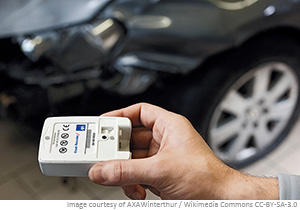
Technology in the auto industry is amazing. From electronic navigation systems that talk to you in a soothing voice to collision avoidance technology, a growing number of cars are equipped with many of the latest bells and whistles the industry has to offer. It's the stuff of science fiction (or at least an episode of the Jetsons). And it's exciting.
This brave new world of automobile accident avoidance mobile/broadband telecommunications technology is often categorized under the broad general term of "telematics."
There is considerable existing and emerging tech that falls under that category. One of the key components – and something of real interest to adjusters – is Event Data Recorders (EDR). Think of the EDR as a kind of black box, but one that only records the few seconds before and after impact.
While promising in terms of driver and passenger safety, there's an important question we must ask: will this great data consistently get into the hands of adjusters?
It should. Think of what we could do to better resolve claims if we had definitive information about accidents such as were the brakes applied, for how long, the exact speed upon impact, how long the driver decelerated or accelerated before impact, if the driver was trying to brake just prior to impact and more.
We know this technology works because it is already being used by many companies with large commercial truck fleets. When investigating accidents involving trucks, adjusters now have an additional tool to use to determine the factors.
The National Highway Traffic Safety Administration (NHTSA) estimates that some 91% of cars on the road today have EDR. Despite its widespread use, availability to the claims industry is still very limited. Why is that? There are some key factors influencing adoption:
- Who owns all that data? Is it the owner of the car, the automobile manufacturer, the insurer, law enforcement, attorneys, or some government entity like the NHTSA? It's kind of a tricky issue, as each automobile manufacturer has its own proprietary approach to EDR.
- There is currently a hodgepodge of legislation governing EDR. Some states allow it, some don't. In fact, out of privacy and other concerns, some states even have mandates that nullify use of EDR data. As a result, many insurers haven't determined what to do with EDR data, let alone how to work appropriate language into their policies.
Clearly, there is still much we need to do to increase adoption of EDR technology for claims settlements. Let's not wait. The time to start preparing for this new tech is now.
As an industry, we need to encourage standardization of EDR technology and adoption of uniform state laws governing its use. We need to start more pilot programs and work to train our adjusters on how to maximize the data contained in EDRs. Insurers should include language in their policies granting them immediate access to the technology in the event of an accident. And, we need to encourage car manufacturers to do more to expand utilization of not just EDR technology, but other collision and accident avoidance tech. Let's not just record data – let’s do more to prevent accidents.
We have a lot more to do to lay the groundwork for use of EDR. But it is coming. As of this year, all new cars sold in the U.S. must include EDR tech. EDR tech has been used in more than 100 court cases, so legal precedents have been set. We can make this tech work – like the commercial says, we need to "just do it."
What do you think of this tech for adjusters? Have you used it? What concerns you and what do you think is promising? Stay tuned for more detailed insights into this important topic for our industry.
Mario Rodriguez, Director National Technical Compliance